powerhse
Back to ChroniclesBack to Johnson Will Replace Bridge
Friday, March 16, 2001
Power House Covered Bridge Down due to Snow-load
Thursday, March 8, 2001 at 5:00 p.m. the Power House Covered Bridge collapsed under a roof-load of heavy wet snow. The top-structure crashed down onto the self-supporting bridge deck, the trusses thrown outward and into the Gihon River. Rescue crews rushed to clear the debris from the still-standing bridge deck, not knowing if anyone was trapped beneath it. Miraculously, no one was.
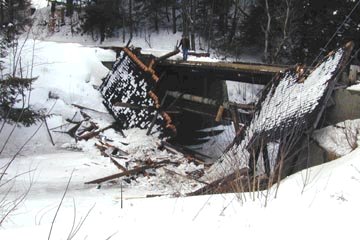 Photo taken from Route 100C, downstream from the bridge.
Photo taken from Route 100C, downstream from the bridge.The Surviving Bridge Deck, or floor, is supported by steel girders and is undamaged.. When railings are installed, said Johnson Selectboard Chairman Eric Osgood, traffic can resume using the span.
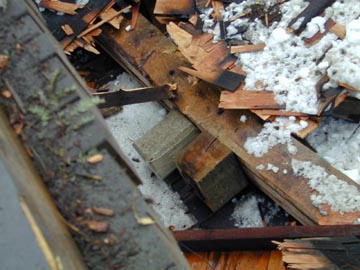 In this photo part of the down-stream bottom chord can be seen in the wreckage.
Note the lower end of a queenpost is visible. Next to it is a large block of timber bolted to the
bottom of the chord. This is the stub of the original floor beam sawed off when the bridge deck
was separated from the truss to be supported by steel girders.
In this photo part of the down-stream bottom chord can be seen in the wreckage.
Note the lower end of a queenpost is visible. Next to it is a large block of timber bolted to the
bottom of the chord. This is the stub of the original floor beam sawed off when the bridge deck
was separated from the truss to be supported by steel girders. From the day of the collapse, the site has had a constant stream of visitors, many of them elderly, all of them saddened by the loss. Will the bridge be restored, everyone asks. Senator Jeffords was advised of the loss and he has already offered to find funds put the old bridge back.
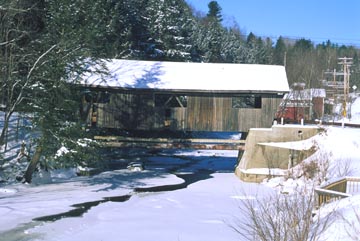 This photo was taken in the winter of 1997. Note the old Power House in the right
background.
This photo was taken in the winter of 1997. Note the old Power House in the right
background.Historically, the bridge-owning towns hired a person each year whose job was to "snow the bridge," putting snow on the bridge floor so sleighs could get through. John Weaver, a Vermont Covered Bridge Society member and structural engineer for VTrans said that a person also was hired by the towns to see that the bridge roofs were kept clear of snow, but the practice died out when most bridges became roofed with metal--metal roofs tend to shed snow. The Power House Bridge used wooden shingles, which tend to retain snow-load, John Weaver said..
Power House Covered Bridge: 1870 - 2001
According to a History of the Town of Johnson, Vt. 1784 - 1907, compiled by the Oread Literary Club, a bridge was built over the Gihon River in 1870 to connect School Street with the road that became Route 100C. In those years the span was referred to as the School Street Bridge. In 1895 the incorporated village of Johnson constructed a water driven power house just above the bridge, and the span came to be known as the Power House Bridge.
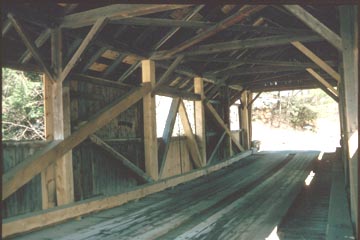 This interior-view of the Power House Bridge was taken in the winter of
1993. Notice the lack of collar ties on the roof rafters. This was pointed out to me
by Neil Daniels, covered bridge builder from Ascutney, Vt. (If collar ties were used the roof
rafters would look like the letter "A".)
This interior-view of the Power House Bridge was taken in the winter of
1993. Notice the lack of collar ties on the roof rafters. This was pointed out to me
by Neil Daniels, covered bridge builder from Ascutney, Vt. (If collar ties were used the roof
rafters would look like the letter "A".) The seventy-three-foot structure is a queenpost truss with massive timbers. The queenposts measure 12 by 10 inches, the diagonals 10 by 10 inches. The bridge was reconstructed in 1960, and again in 1993 because the bridge was developing a decided sag. The truss was renovated with much of the original timber replaced. Unfortunately, the bridge continued to sag, and was closed again in 1995 for further work.
The bridge, serving a popular shortcut to Johnson State College and the elementary school, has been in daily use, the traffic flow heavy at all hours.

Friday, March 16
Blow and Cote, contractors from Morrisville, have pulled the timbers and debris out of the Gihon River and stacked it all for sorting and hauling.
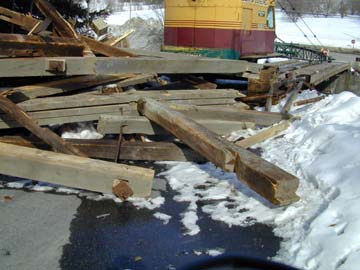 In this photo, one of the down-stream queenposts can be seen
still attached to the chord. The queenpost brace and the counter-brace are nearby, strung on the
queen-rod still bolted to the chord. Notice the stub of the floor beam, sawed off short to
make way for the steel beams that independently supported the bridge floor. This change was
probably made in one of the later reconstructions.
In this photo, one of the down-stream queenposts can be seen
still attached to the chord. The queenpost brace and the counter-brace are nearby, strung on the
queen-rod still bolted to the chord. Notice the stub of the floor beam, sawed off short to
make way for the steel beams that independently supported the bridge floor. This change was
probably made in one of the later reconstructions.
Notice the tenon at the top of the queenpost. This fit into a mortise in the bottom of the plate timber that ran the length of the bridge supporting the ends of the roof rafters. The plates were mortised above each queenpost to receive the tie-beam tenons.
This writer observed three kinds of damage to the joints between the plates and the tie-beams: 1) the tenon was pulled out of the mortise, breaking the pegs holding them together; 2) the "relish" was broken out of the mortise leaving the pegs intact in the tenon; 3) The "relish" on the tenon was pulled out leaving the mortise and pegs intact. This damage was done by the weight of the snow load pressing down on the rafters, turning the rafters into levers that forced the tie-beam joints apart. The bridge might have been able to support the snow load if collar ties or steel tie-rods were used to augment the tie-beam connections. Joe Nelson, P.O Box 267, Jericho, VT 05465-0267, jcnelson@together.net
Joe Nelson, P.O Box 267, Jericho, VT 05465-0267, jcnelson@together.netNo part of this web site may be reproduced without the written permission of Joseph C.
Nelson
Text Copyright © 2001, Joseph C. Nelson
Photographs Copyright ©, 2001, Joseph C. Nelson
This file posted March 10, 2001
This file updated March 23, 2001